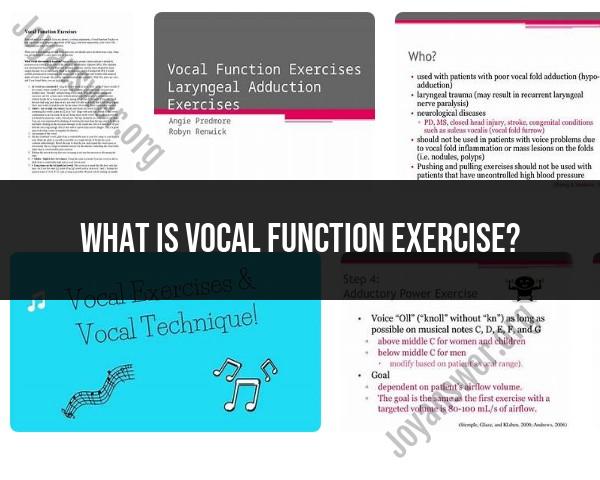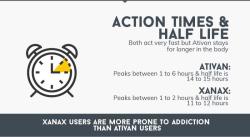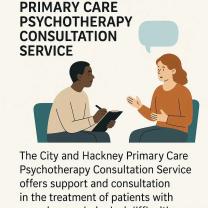What is vocal function exercise?
Vocal Function Exercises (VFEs) are a set of exercises and techniques designed to improve and optimize the function of the vocal folds (vocal cords) and the overall health and strength of the voice. These exercises are commonly used by speech-language pathologists, singing teachers, and vocal coaches to help individuals maintain or regain healthy vocal function, prevent voice disorders, and enhance voice quality and endurance.
The primary goals of Vocal Function Exercises include:
Strengthening the Vocal Muscles: VFEs aim to strengthen the intrinsic laryngeal muscles that control the vocal folds, improving vocal power and control.
Enhancing Vocal Endurance: These exercises can help individuals develop greater stamina and reduce vocal fatigue, making it easier to speak or sing for extended periods.
Improving Vocal Range and Flexibility: VFEs can enhance the range and flexibility of the voice, enabling better pitch control and adaptability in various vocal tasks.
Promoting Proper Vocal Technique: Vocal function exercises can teach and reinforce proper vocal production techniques, including breath control, resonance, and articulation.
Here are some common Vocal Function Exercises:
Lip Trills: Make a "brrr" or "prrr" sound while blowing air through closed lips. This exercise helps with airflow, relaxation, and vocal flexibility.
Sirens: Glide smoothly from your lowest to highest pitch and back down, creating a siren-like sound. This exercise helps with vocal range and flexibility.
Humming: Humming exercises engage the vocal folds in a gentle and controlled manner, promoting resonance and balance.
Pitch Glides: Glide through different pitches from low to high and vice versa. This exercise can help with pitch control and flexibility.
Resonance Exercises: These exercises focus on using different resonators, such as chest, head, and mask, to create specific vocal qualities and improve vocal projection.
Sustainable Singing: Sustain a single note or vowel sound, gradually increasing the duration and pitch range over time to build endurance and control.
Semi-Occluded Vocal Tract Exercises: Use partially blocked sounds, such as straw phonation (singing or speaking through a straw), to control and balance airflow and pressure within the vocal tract.
It's important to note that Vocal Function Exercises should be practiced with guidance from a qualified professional, such as a speech-language pathologist or vocal coach, especially if you have specific vocal concerns or challenges. They can tailor exercises to your individual needs and ensure that you are performing them correctly and safely. If you experience persistent vocal problems or discomfort, it's important to seek professional evaluation and treatment.
What is vocal function exercise, and how does it benefit your voice?
Vocal function exercises are exercises that help to strengthen and improve the function of the vocal folds. The vocal folds are two bands of muscle tissue that vibrate to produce sound. Vocal function exercises can help to improve the range, power, and endurance of the voice. They can also help to reduce the risk of vocal problems, such as hoarseness and vocal fatigue.
How can vocal function exercises help individuals with vocal disorders or voice issues?
Vocal function exercises can be very beneficial for individuals with vocal disorders or voice issues. These exercises can help to improve the strength and coordination of the vocal folds. They can also help to reduce inflammation and improve the overall health of the vocal folds.
Vocal function exercises are often part of the treatment plan for a variety of vocal disorders, including:
- Vocal nodules
- Vocal polyps
- Vocal fold paresis
- Vocal fold paralysis
- Voice tremors
- Muscle tension dysphonia
- Spasmodic dysphonia
- Vocal fold scarring
Are there specific vocal function exercises that singers or public speakers use to improve their vocal performance?
Yes, there are a number of specific vocal function exercises that singers and public speakers use to improve their vocal performance. These exercises can help to improve the range, power, and flexibility of the voice. They can also help to improve breath support and vocal technique.
Some of the vocal function exercises that singers and public speakers use include:
- Straw phonation: This exercise involves blowing a gentle stream of air through a straw while producing a humming sound.
- Lip trills: This exercise involves vibrating the lips while producing a humming sound.
- Tongue trills: This exercise involves vibrating the tip of the tongue while producing a humming sound.
- Pitch glides: This exercise involves sliding the voice up and down a range of pitches while maintaining a constant tone.
- Arpeggios: This exercise involves singing a series of notes that are one step apart in pitch.
What is the recommended frequency and duration of vocal function exercises?
The recommended frequency and duration of vocal function exercises will vary depending on the individual's needs. However, it is generally recommended to do vocal function exercises for at least 20 minutes per day, 5 days per week.
It is important to start slowly and gradually increase the intensity and duration of vocal function exercises over time. It is also important to listen to your body and rest if you experience any pain or discomfort.
Can vocal function exercises be self-administered, or should they be done under professional guidance?
Vocal function exercises can be self-administered, but it is important to get instructions from a qualified voice therapist. A voice therapist can help you to choose the right exercises for your individual needs and to ensure that you are doing the exercises correctly.
If you have any vocal disorders or voice issues, it is important to see a voice therapist for diagnosis and treatment. A voice therapist can develop a treatment plan that includes vocal function exercises, as well as other therapies, such as voice therapy and vocal hygiene counseling.
By following the recommendations of a qualified voice therapist, you can safely and effectively use vocal function exercises to improve your voice.













